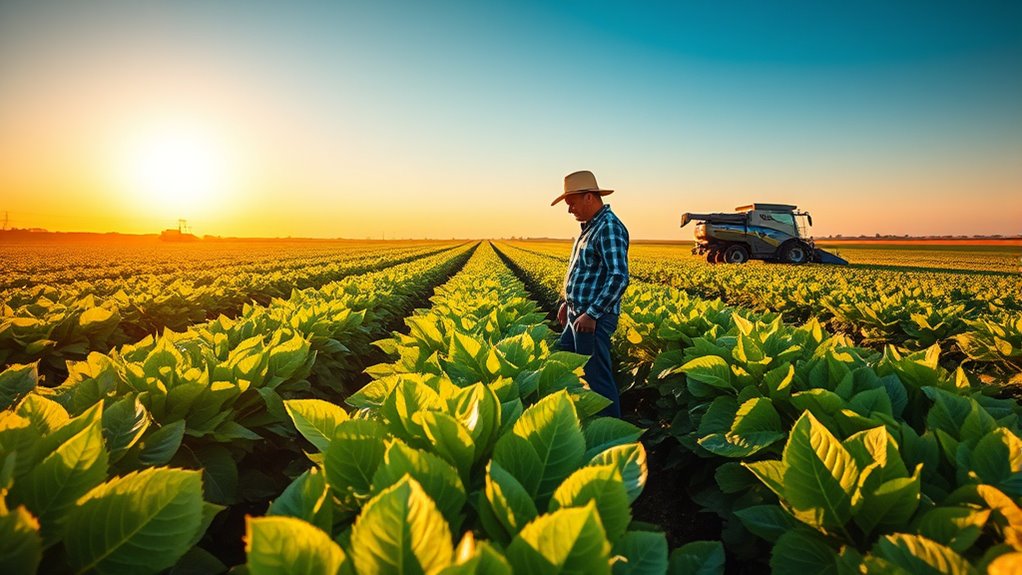Commercial farming means you can produce crops or livestock on a large scale to maximize profits and meet market demands. It allows you to specialize in certain products, using technology like precision agriculture and automation to boost efficiency. While you'll benefit from job creation and access to broader markets, you'll also face challenges like resource scarcity and environmental concerns. There's much more to explore about how these elements interact and shape your farming choices.
Key Takeaways
- Commercial farming focuses on large-scale production, aiming for high yields and efficient resource use to maximize profits for farmers.
- It creates job opportunities, stimulating local economies and providing farmers with a stabilized income through market-aligned crop selection.
- Technological innovations, such as precision agriculture and automation, enhance productivity and reduce operational costs for farmers.
- Farmers face challenges like water scarcity, high energy costs, and labor shortages, impacting their operational success and profitability.
- The environmental impacts of commercial farming, including soil degradation and pollution, pose risks that farmers must navigate for sustainable practices.
Understanding Commercial Farming
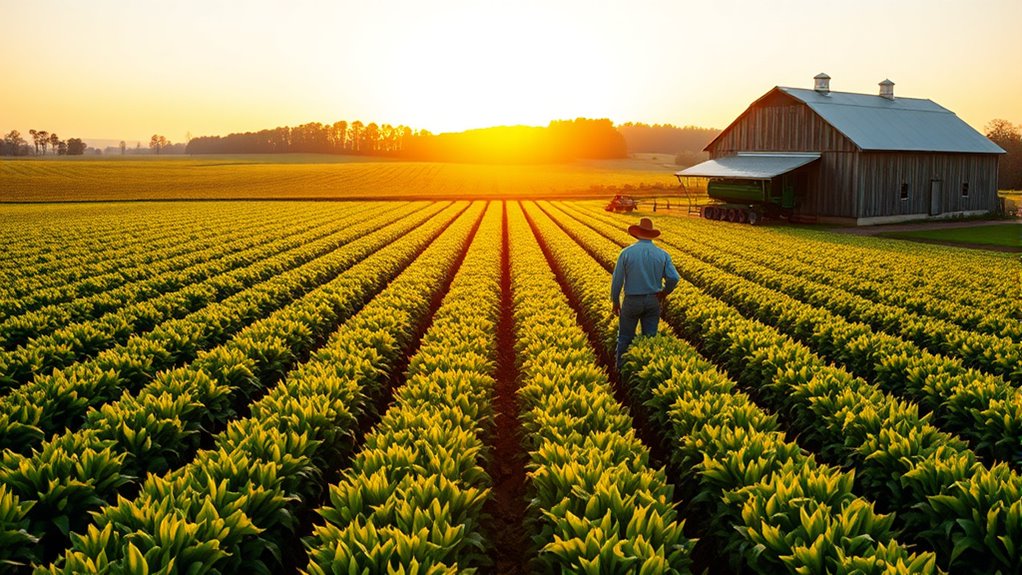
Commercial farming is a dynamic approach to agriculture that focuses on large-scale production to meet market demands.
You're looking at a system designed primarily for profit, emphasizing high yields and efficient resource use. Unlike subsistence farming, you target local, national, and international markets, maximizing your reach.
With substantial investments in land, equipment, and technology, you can specialize in specific crops or livestock, benefiting from economies of scale.
Substantial investments in land and technology enable specialization in crops or livestock, driving economies of scale.
Precision farming techniques, advanced irrigation systems, and genetically modified organisms enhance your productivity.
Plus, integrating into global supply chains allows you to export and import easily.
The commitment to modern methods not only boosts profits but also positions you to meet evolving consumer demands, making commercial farming a key player in today's agricultural landscape.
Economic Benefits for Farmers

While engaging in commercial farming, you can unlock numerous economic benefits that enhance your overall profitability and sustainability.
This approach generates job opportunities, boosting local economies and providing livelihoods for many families. By aligning your crop selection with market trends, you can meet consumer demand and stabilize your income.
Efficient resource utilization helps reduce waste, optimizing production costs. You'll also benefit from bulk purchasing, cutting down expenses on inputs.
With better access to markets, you can sell at competitive prices, increasing your profits. Additionally, integrating into global supply chains opens up international trade opportunities, further contributing to your economic growth.
Technological Innovations in Agriculture
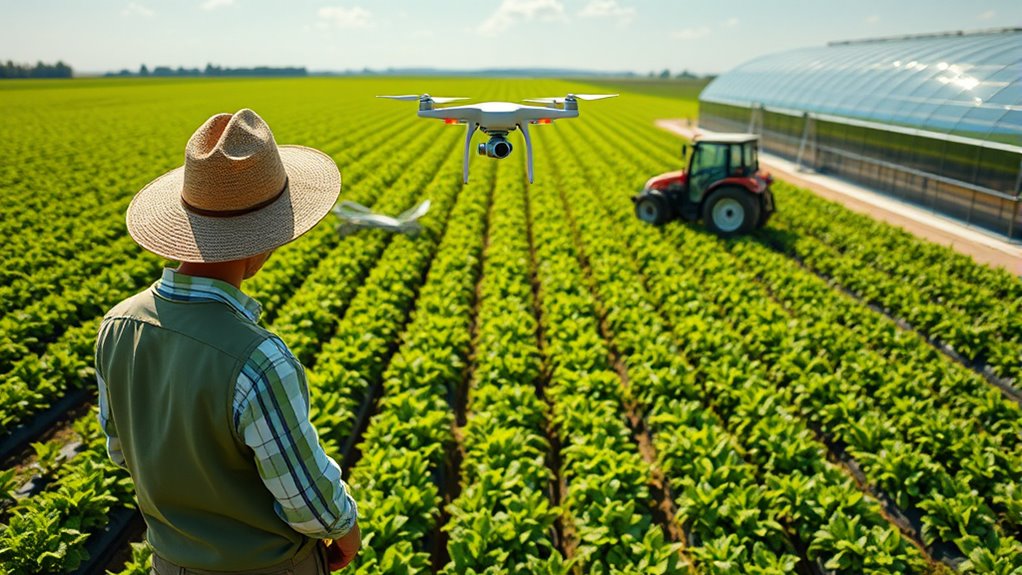
As advancements in technology reshape the agricultural landscape, farmers can leverage innovative tools to enhance productivity and efficiency.
Precision agriculture technologies, like GPS-guided tractors and sensor-equipped machinery, help you optimize resource use. With data analytics, you can analyze soil conditions, weather, and crop health to make informed decisions. Satellite imaging allows for monitoring crop growth and forecasting weather effectively. Additionally, incorporating heat pump technology can further improve energy efficiency on farms. Moreover, utilizing hydrogen fuel cells as an energy source can provide a sustainable alternative for powering agricultural equipment.
Automation plays a crucial role, too; using drones and autonomous machinery streamlines operations, and robots tackle repetitive tasks like planting and harvesting.
Artificial intelligence and machine learning can predict weather patterns and optimize resource allocation, making your farming practices smarter. Embracing these technologies not only boosts yields but also reduces labor costs, paving the way for a more sustainable and profitable future. Additionally, understanding water sources is crucial for effective resource management on farms, ensuring that crops and livestock receive adequate hydration.
Environmental Impact of Commercial Farming
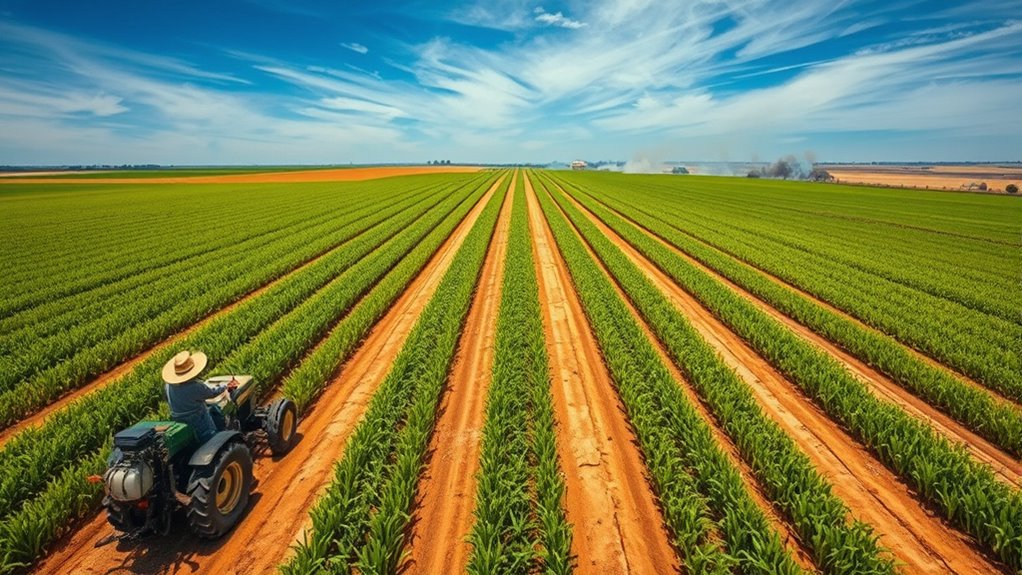
The environmental impact of commercial farming is significant, affecting air quality, water sources, and biodiversity.
You'll notice that air pollution arises from fossil fuel use and methane emissions from livestock. Water pollution is another concern, with manure from concentrated animal feeding operations (CAFOs) contaminating waterways, harming aquatic life.
Intensive farming practices lead to soil degradation, nutrient depletion, and erosion. The extensive use of pesticides and fertilizers can linger in the environment, threatening ecosystems.
Additionally, agricultural expansion often results in habitat destruction, causing biodiversity loss. With livestock contributing to 14.5% of global greenhouse gas emissions, these factors combine to create a pressing need for sustainable practices that balance agricultural productivity with environmental health.
Types of Commercial Farming Practices

Commercial farming encompasses various practices tailored to meet the demands of modern agriculture.
Dairy farming focuses on producing milk and dairy products, often using advanced technology and large-scale operations.
Grain farming, which produces staples like wheat and corn, requires significant investment in machinery and relies heavily on fertilizers.
Livestock ranching raises animals for meat, utilizing software for efficient management, particularly in regions like the EU and Brazil.
Mixed farming systems combine crops and livestock, enhancing sustainability and diversifying income streams.
Lastly, plantation farming grows cash crops such as coffee and rubber, while horticulture emphasizes fruits and vegetables, playing crucial roles in international trade.
Each practice aims to optimize resources and meet market needs effectively.
Challenges Faced by Commercial Farmers
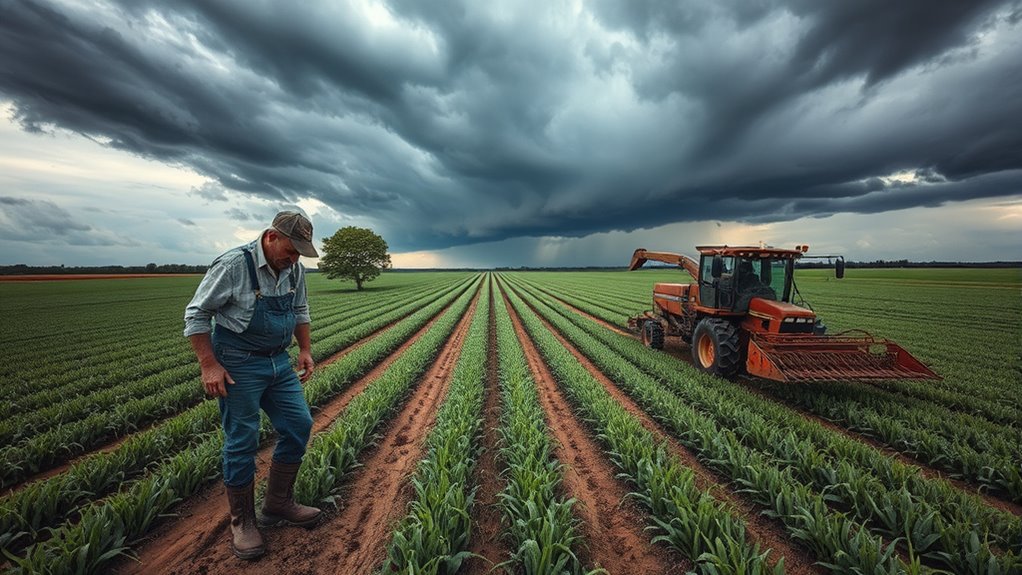
While navigating the complexities of modern agriculture, farmers face a myriad of challenges that threaten their livelihoods and the sustainability of their practices.
Water scarcity is a pressing issue, with commercial farming consuming vast freshwater resources. High energy costs and resource depletion further strain your finances and long-term viability. Climate change complicates these matters, affecting both water availability and energy expenses.
Additionally, soil degradation and deforestation from intensive farming practices harm the environment, while rising input costs and market fluctuations squeeze profits.
Labor shortages and an aging workforce make hiring difficult, further complicating operations. Lastly, navigating complex regulations and weak market connections can hinder your ability to thrive in this competitive landscape.
Strategies for Sustainable Farming Practices
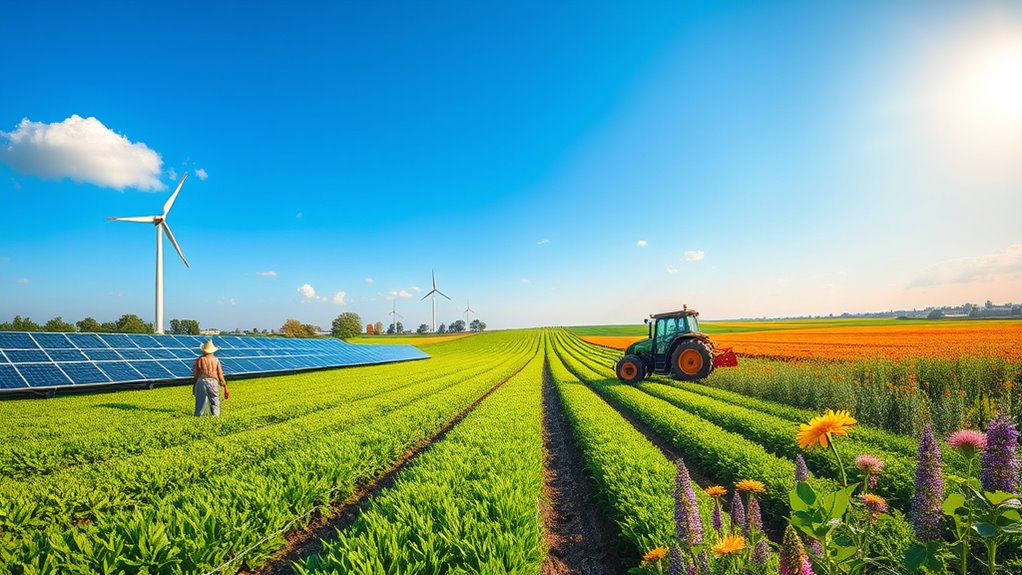
To thrive in today's agricultural landscape, you need to adopt strategies for sustainable farming practices that enhance productivity while safeguarding the environment.
Start with crop rotation and conservation tillage to boost soil health and prevent erosion. Implement cover cropping and add organic matter to enrich soil fertility.
Embrace crop rotation and conservation tillage to enhance soil health and prevent erosion while enriching fertility with cover crops.
For water conservation, switch to drip irrigation and explore rainwater harvesting. Choose drought-resistant crops and utilize precision farming for efficient water use.
Foster biodiversity through agroforestry and polyculture, integrating livestock into your systems. Minimize environmental impact by practicing organic farming and adopting integrated pest management.
These methods not only promote resilience to climate change but also support your community and improve profitability, making your farming operation sustainable for the long term.
Frequently Asked Questions
How Can Small Farmers Compete With Large Commercial Farms?
To compete with large commercial farms, you should focus on diversifying your crops and targeting local markets.
Emphasize quality and unique branding to attract customers who value local produce.
Collaborating with other small farmers can strengthen your market presence.
Additionally, adopting technology like precision farming and digital marketing can enhance efficiency and outreach.
What Financing Options Are Available for Aspiring Commercial Farmers?
Financing options for aspiring commercial farmers are like a toolbox full of varied instruments.
You've got USDA FSA loans for those needing a hand, plus microloans tailored for small operations.
Don't overlook commercial bank loans, which can help you buy land or equipment.
Private lenders and crowdfunding offer flexible solutions too.
How Does Commercial Farming Impact Local Food Systems?
Commercial farming impacts local food systems by boosting economic activity and creating jobs.
When you invest in local farms, your spending generates additional economic benefits for the community. You also support local businesses, enhancing market competition.
However, you might find challenges like market saturation or regulatory compliance.
What Role Do Government Policies Play in Commercial Farming?
Government policies play a crucial role in your commercial farming operations. They provide financial support through programs like countercyclical payments and crop insurance, helping you manage risks and stabilize income.
Additionally, these policies influence market access and trade agreements, impacting how and where you sell your products.
You also benefit from conservation initiatives that promote sustainable practices, ensuring your farming remains viable while addressing environmental concerns.
Can Commercial Farming Practices Be Adapted for Organic Farming?
Imagine a farmer standing at the crossroads, one path leading to conventional methods and the other to organic practices.
You can adapt your commercial farming techniques to embrace organic methods. By harnessing technology for precision agriculture, using sustainable inputs like compost, and diversifying crops, you'll cultivate healthier soil and higher market prices.
The journey may be challenging, but the rewards of sustainability and consumer demand await you at the end of this new road.
Conclusion
In conclusion, commercial farming can be a game changer for many farmers, offering economic benefits and technological advancements. However, it also comes with environmental challenges that can't be ignored. As you navigate this landscape, consider: how can you balance profitability with sustainability to protect our planet for future generations? By embracing innovative practices and addressing these challenges head-on, you can thrive in the commercial farming sector while contributing to a healthier environment.

